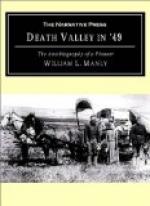In summer there were plenty of strawberries, raspberries, whortleberries and blackberries growing wild, but all the cultivated fruit was apples. As these ripened many were peeled by hand, cut in quarters, strung on long strings of twine and dried before the kitchen fire for winter use. They had a way of burying up some of the best keepers in the ground, and opening the apple hole was quite an event of early spring.
The children were taught to work as soon as large enough. I remember they furnished me with a little wooden fork to spread the heavy swath of grass my father cut with easy swings of the scythe, and when it was dry and being loaded on the great ox-cart I followed closely with a rake gathering every scattering spear. The barn was built so that every animal was housed comfortably in winter, and the house was such as all settlers built, not considered handsome, but capable of being made very warm in winter and the great piles of hard wood in the yard enough to last as fuel for a year, not only helped to clear the land, but kept us comfortable. Mother and the girls washed, carded, spun, and wove the wool from our own sheep into good strong cloth. Flax was also raised, and I remember how they pulled it, rotted it by spreading on the green meadow, then broke and dressed it, and then the women made linen cloth of various degrees of fineness, quality, and beauty. Thus, by the labor of both men and women, we were clothed. If an extra fine Sunday dress was desired, part of the yarn was colored and from this they managed to get up a very nice plaid goods for the purpose.
In clearing the land the hemlock bark was peeled and traded off at the tannery for leather, or used to pay for tanning and dressing the hide of an ox or cow which they managed to fat and kill about every year. Stores for the family were either made by a neighboring shoe-maker, or by a traveling one who went from house to house, making up a supply for the family—whipping the cat, they called it then. They paid him in something or other produced upon the farm, and no money was asked or expected.
Wood was one thing plenty, and the fireplace was made large enough to take in sticks four feet long or more, for the more they could burn the better, to get it out of the way. In an outhouse, also provided with a fireplace and chimney, they made shingles during the long winter evenings, the shavings making plenty of fire and light by which to work. The shingles sold for about a dollar a thousand. Just beside the fireplace in the house was a large brick oven where mother baked great loaves of bread, big pots of pork and beans, mince pies and loaf cake, a big turkey or a young pig on grand occasions. Many of the dishes used were of tin or pewter; the milk pans were of earthenware, but most things about the house in the line of furniture were of domestic manufacture.




